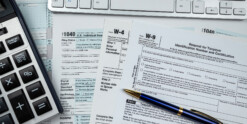The best time to plant an apple orchard is a decade ago since that’s how long it takes to bear fruit. The second-best time is today.
If you’re like most Americans, you probably have a lot of catching up to do.
The National Institute on Retirement Security has found that 62% of working households between the ages of 55 and 64 had retirement savings worth less than their annual income. The same study reported that the median retirement account balance for households nearing retirement was $14,500.
Another study, courtesy of Transamerica, found that 46% of Americans are just guessing at how much they’ll need for retirement. This is not a plan, folks — it’s wishful thinking.
If you’re feeling a cold sweat reading these statistics while considering your savings account, my advice is not to panic. Even if you’re in one of these situations, things aren’t as hopeless as they may appear. You just have some work to do.
Here’s how to get started. There are three main points I want to drive home as the foundation of your work: Live below your means, start saving and start investing.
I’ve seen plenty of folks throughout my career who postponed saving for retirement (for various reasons) until they were in their 40s, 50s and even 60s. They were able to catch up, and so can you.
Here’s how you do it, by the numbers.
For many Americans, the retirement savings benchmark is $1 million, so let’s use that number.
• Let’s say you’re 40 and plan to save until age 60 because you’re eyeing an early retirement.
Assuming a 5% rate of return, you would need to save $30,242 annually to make it to the million-dollar mark by your 60th birthday.
• Now, imagine that you’re 50 and plan to save until the typical retirement age of 65.
Again, assuming that 5% rate of return, you would need to put away $46,342 each year to join the millionaire club.
• What about if you’re age 60? There’s still hope, my friends. Let’s say you’re going to stay in the workforce for another 10 years before you retire and are looking at a realistic goal of attaining $500,000 for retirement.
At our same rate of return, you would need to stash $39,752 per year to reach your goal.
Now, I didn’t just pull $500,000 out of thin air — this number has tremendous significance.
The research for my book, “You Can Retire Sooner Than You Think,” showed that the happiest retirees weren’t necessarily the ones that had millions piled in their bank accounts. Instead, these happy folks had at least reached the important $500,000 level in retirement savings.
So, if you’re looking for magic numbers when it comes to retirement savings, $500,000 is a key checkpoint, according to my research on happy vs. unhappy retirees.
As you can see, using the elements of living below your means and getting started on both saving and investing, you can get to a comfortable retirement.
When you’re first starting out, it’s critical to develop a vision for your retirement. Start by answering the big questions: How often do you want to travel? Do you want a second home? Are you looking to downsize? What about part-time work? Once you have your ideal lifestyle in mind, you can determine how much you’ll need to pay for it. You can use an online calculator, such as the one I offer on wesmoss.com, to help you do exactly that.
Once you have your spending estimate, start to consider how you’ll meet your need. Things that you may have to do are boost your savings rate or consider pushing back your retirement a few years (especially if you enjoy your work).
As for 401(k) plans, when you hit age 50, you’re allowed a “catch-up” provision. Instead of being limited to the standard maximum contribution of $19,000 per year, you can save an additional $6,000. All in, you can put $25,000 into your account annually. This increase can turbo-boost your savings. And whatever you do, don’t leave free money on the table. I’m talking about employer matches here. The most common match I see is 3%. If you’re making a salary of $100,000 a year, that’s an additional $3,000 added to the pot.
You’ll also want to factor in other retirement revenues into your overall calculations.
Your monthly Social Security payments can vary dramatically depending on when you start taking benefits. So, do that math or work with a professional to develop the best plan for you. If you’re fortunate enough to have a pension, don’t forget to count that monthly check, too.
Rental properties are also a great way to generate a steady stream of income. If money is too tight to buy a rental house or condo, you still have options. If you’re already looking to downsize in retirement, think about renting your current paid-off home for a few years.
You may want to start thinking about taking a part-time job during retirement. With some digging, you can find something that will bring you the dual benefits of extra income and enjoyment in your first few post-career years.
Of course, spending is part of the equation, too. There are plenty of ways to reduce the cost of living during your retired years. Think about whether you still need a four-bedroom house. Heck, think about whether you even need to live in your current city. There are numerous metropolitan areas across the U.S. that offer a great lifestyle at a low cost of living.
Plus, your options are global. More and more Americans are retiring to countries where they can live comfortably on a fraction of what they’d spend back home.
Regardless of your situation, you can most likely still carve out a great retirement. But, of course, the most essential part of doing anything is simply getting started.
So, plant your apple orchard today. Figure out where you are, what you need, and make a plan. The fruits of your labor will be all the sweeter.
Read original AJC article here
DISCLOSURE
This information is provided to you as a resource for informational purposes only and should not be viewed as investment advice or recommendations. Investing involves risk, including the possible loss of principal. There is no guarantee offered that investment return, yield, or performance will be achieved. There will be periods of performance fluctuations, including periods of negative returns. Past performance is not indicative of future results when considering any investment vehicle. This information is being presented without consideration of the investment objectives, risk tolerance, or financial circumstances of any specific investor and might not be suitable for all investors. This information is not intended to, and should not, form a primary basis for any investment decision that you may make. Always consult your own legal, tax, or investment adviser before making any investment/tax/estate/financial planning considerations or decisions.













